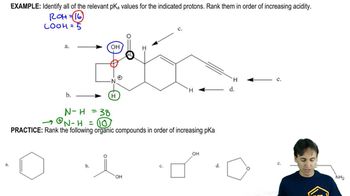Citrus fruits are rich in citric acid, a compound with three COOH groups. Explain the following:
b. The third pKa is greater than the pKa of acetic acid.
 Verified step by step guidance
Verified step by step guidance Verified video answer for a similar problem:
Verified video answer for a similar problem:



 9:36m
9:36mMaster The 12 pKa values you want to memorize (because they are important!). with a bite sized video explanation from Johnny
Start learning